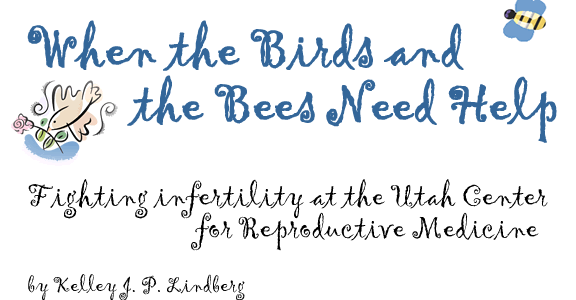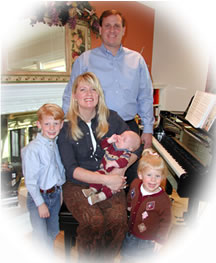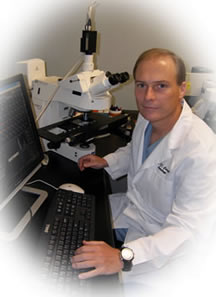
Vol. 15 No. 3 |
Winter 2005-06 |

Ten months is a long time to wait when you’re trying to get pregnant and you’re in your late 30s. But that’s how long it took for Karen and James Horne to conceive their first baby, David.
When they decided to have a second child, Karen and James knew it might take a while. But after a year and a half with no results, they realized they needed help.
 |
| Karen
and James Horne with their children David, Olivia, and baby Nathan.
|
Since her 20s, Karen has had endometriosis—a painful condition in which the type of tissue that lines the inside of the uterus grows outside it, attaching to and damaging other organs or ligaments, interfering with the menstrual cycle, and causing internal bleeding and inflammation. In addition, Karen suffers from rheumatoid arthritis. Both diseases, combined with the fact that Karen was approaching her late 30s, were working against the Hornes’ efforts to conceive. So they turned to Karen’s longtime gynecologist, C. Matthew Peterson, M.D., a professor and chief of the Division of Reproductive Endocrinology in the Utah Center for Reproductive Medicine (UCRM) at the University of Utah School of Medicine, where Karen and James participated in a series of tests and procedures.
After evaluating their options, the Hornes decided that the odds for natural conception were not in their favor. It would be exceedingly difficult—if not impossible—for Karen to conceive. Peterson proposed the option of in vitro fertilization (IVF). “He was slow to suggest it,” says Karen. “I like that about the U’s fertility center. They make sure you have a good case for IVF before they tell you to spend 10 thousand dollars.” IVF did the trick. At 38, Karen gave birth to Olivia.
Treating
Infertility
Since 1982, the Utah Center for Reproductive Medicine has been helping
couples like the Hornes overcome infertility.
The UCRM brings together two branches of the University of Utah School of Medicine: The Andrology Laboratory, which is focused on the science of male sperm function, is part of the Department of Urology, under the Department of Surgery; the Division of Reproductive Endocrinology, under the Department of Obstetrics and Gynecology, deals with the female issues of reproduction. As Kirtly Parker Jones, M.D., a professor and reproductive endocrinologist at the UCRM, says with a grin, “Since it takes both a man and a woman to conceive a child, it takes both departments to make up the UCRM.”
While the UCRM is part of the University’s School of Medicine, its funding is entirely self-generated.
 |
| C. Matthew Peterson, M.D. |
Infertility can affect both men and women, and factors include physical problems, diseases, genetics, environmental contaminants, and even emotional issues. Many of its causes are still only suspected, and research is ongoing to determine how and why diseases or physical characteristics impact a couple’s ability to conceive. Sometimes, no root cause can be determined at all.
The UCRM offers a range of services to help couples overcome fertility obstacles. Says Peterson, “We offer all types of treatment options, including adoption referrals.”
First, doctors at the UCRM test and evaluate an infertile couple’s situation, then recommend appropriate therapeutic interventions. The doctors can provide reconstructive uterine surgery to repair a congenitally abnormal uterus, ovulation induction to help women successfully produce eggs during their menstrual cycle, and fertility surgery to repair problems such as endometriosis. If sperm isn’t reaching fertile eggs, doctors can perform artificial insemination to deposit the husband’s or a donor’s sperm directly into the woman’s uterus.
When these types of procedures don’t work, the UCRM offers Advanced Reproductive Therapy (ART), which includes IVF. In IVF, the woman’s eggs are carefully withdrawn from her ovaries, fertilized by the husband’s sperm in the lab, monitored, and evaluated. Then the most viable embryos are inserted into the woman’s uterus.
IVF can also be performed with a donor egg, or with ICSI (intracytoplasmic sperm injection), where the sperm is injected directly into an egg. If IVF produces more than two or three viable embryos, the UCRM can provide cryopreservation—freezing the extra embryos so that the couple can have them implanted at a later date.
The UCRM also offers Preimplantation Genetic Diagnosis (PGD). Before an embryo is inserted in the woman’s uterus, technicians can carefully extract a single cell and have it analyzed for more than 100 life-threatening genetic diseases or other birth defects.
A
Moving Success
The UCRM used to be located inside the University of Utah hospital, but
its offices and labs were scattered across several floors. In autumn 2002,
the UCRM moved to a new facility on nearby Arapeen Drive in Research Park.
 |
| Douglas
T. Carrell, Ph.D. |
According to Douglas T. Carrell, Ph.D., director of Andrology/Embryology at the UCRM, not only did the move make access more convenient for the patients, doctors, and nurses in the UCRM, but it also made a difference in the success rate of the fertility treatments. “The main improvement from my perspective is that we have complete control over the air in the labs. One of the most critical things in growing embryos is the air quality.”
Before the move, air in the labs was subject to contamination from the rest of the hospital. The UCRM’s birth rate from IVF procedures was between 25 percent and 46 percent, depending upon the exact procedures used, the mothers’ ages, and so on. Now that the UCRM is in its new facility, the birth rate has surged to between 52 and 62 percent.
Average birth statistics are difficult to compare because of so many variables between clinics, but the National Centers for Disease Control and Prevention (CDC) estimated the national success rate in 2002 at under 30 percent. “Part of the increasing success of IVF at the UCRM,” says Jones, “is advances in the lab that allow us to successfully culture embryos, including having all the air in the embryo lab triple-filtered and UV-irradiated to decrease the toxins that you and I breathe every day.”
Advancing the Field
 |
| Kirtly Parker-Jones, M.D. |
The UCRM handles more than 5,000 patient visits and 300 IVF cycles per year. But treating patients is only half of the story. Doctors and technicians at the UCRM are also involved in extensive research programs. By participating in these research studies, some patients can reduce the cost of their treatment. “Our clinical research studies,” says Peterson, “cover everything from ovulation monitoring to ovulation-induction techniques. For example, we have a large ongoing research program studying the genetics of Polycystic Ovary Syndrome,” a condition in which ovaries produce higher than normal amounts of androgens, which can interfere with egg development and release.
A primary focus of the UCRM’s research is on male infertility. “We are known for excellence in male reproductive research,” says Jones. “Specifi cally, we are researching sperm function and the genetics of male infertility. We’re also expanding our research into the environmental and personal factors that adversely affect male fertility.”
Carrell adds, “Our goal is to get to the point where we can quickly and cheaply identify the underlying problem in any man who comes in with an infertility problem, understand the risks, and know how to treat him successfully.” To further the fi eld, in January Carrell and the UCRM will host the fi rst international symposium on the genetics of male infertility.
Cryopreservation of eggs is another of the UCRM’s areas of research. While frozen embryos are routinely and successfully implanted, freezing unfertilized eggs is new territory.
“Progress comes in ebbs and flows,” says Carrell, “and right now is an exciting time in the field of reproductive medicine.”
Success
in Real Terms
For couples like the Hornes, all the statistics boil down to only one
measure of success—having a baby. In July, Karen and James had their
third child, Nathan, the result of another successful round of IVF. “I
really do like the staff there,” says Karen. “I found them
to be very educated and empathetic, and they made the process as pleasant
as possible. We are so lucky to have this fertility clinic here in Utah.
It has provided us with a family!”
—Kelley J.P. Lindberg is a Layton-based freelance writer.
Mastering Genetic Counseling
In August, six students were the fi rst selected to enter the University of Utah School of Medicine’s new Graduate Program in Genetic Counseling. This two-year, full-time master’s degree program, which is accredited by the American Board of Genetic Counseling (ABGC), is the result of collaboration between the University’s human genetics, pediatrics, and obstetrics and gynecology departments, and the Hunstman Cancer Institute.
Genetic counselors study and analyze the risks of genetic diseases and birth defects. Because the field is relatively new, only about 30 genetic counseling degree programs exist in the United States and Canada, but the need for trained genetic counselors is growing rapidly. Their skills are in demand in diverse areas such as academic medicine, private hospitals, industry, national and state health organizations, private practice, and education.
A genetic counselor’s primary focus is usually patient care—identifying families who may be at risk for genetic disorders or birth defects, analyzing those risks, and educating the families about their options. In addition, many genetic counselors also are involved in research.
The University of Utah expects to admit only six to eight students into the program each year. The training includes genetics coursework, psychosocial skill training, an independent research project, and clinical training. Admission requirements include a baccalaureate degree with a 3.0 GPA, several required college-level courses, advocacy experience, and acceptable GRE scores. For more information about the program and its specific admission requirements, visit